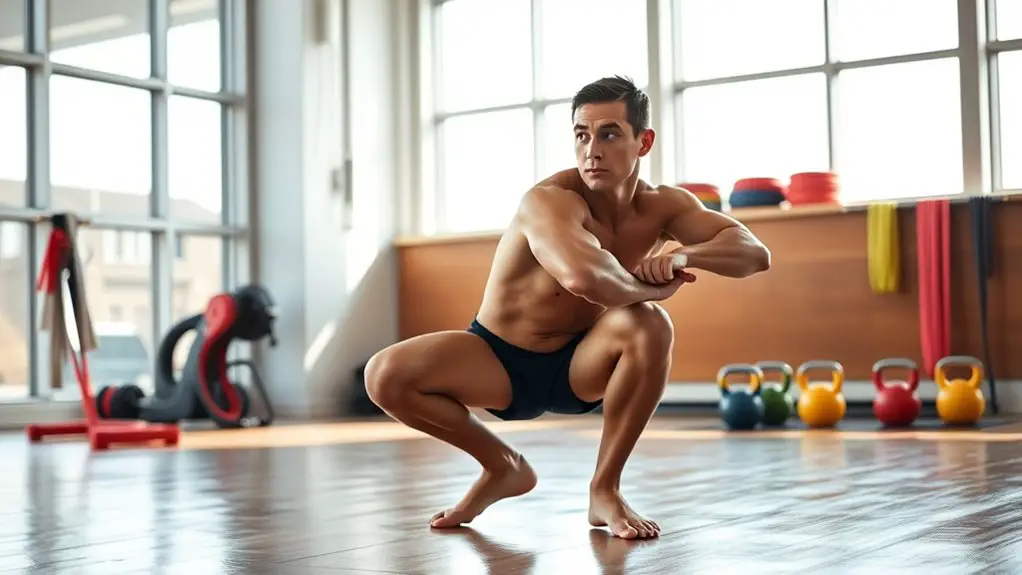If you're looking to boost strength and stability, incorporate push-ups, squats, and planks into your routine. Push-ups target your upper body while squats build lower body power. Planks enhance core stability, critical for overall strength. Add lunges to improve your balance and coordination, and glute bridges to strengthen your posterior chain. For a little more cardio while building endurance, try mountain climbers. There's plenty more to explore on these effective exercises.
Push-Ups: Building Upper Body Strength
Push-ups pack a powerful punch when it comes to building upper body strength. They engage your chest, shoulders, triceps, and core, making them a go-to exercise for anyone seeking freedom in their fitness routine. You don't need fancy equipment or a gym membership—just your own body and a bit of space.
Start by getting into a plank position, keeping your body straight from head to heels. Lower yourself down, then push back up. It's a simple movement, but it can transform your strength over time.
You can modify them to fit your level, whether you're a beginner or looking for a challenge. The beauty of push-ups lies in their versatility; you can switch up your hand placement or try variations like incline or decline push-ups. Embrace the freedom to explore and push your limits—your upper body will thank you for it! Moreover, push-ups can enhance overall upper body power for improved athletic performance in various sports.
Squats: Developing Lower Body Power
After building upper body strength with push-ups, it's time to focus on your lower body. Squats are a fantastic way to develop lower body power, enhancing your strength and stability. They target your quads, hamstrings, and glutes, giving you the freedom to move with confidence. Incorporating squats into your routine not only builds strength but also improves muscular endurance, which is essential for sustaining performance in various activities.
Here's a quick guide to different squat variations:
| Squat Type | Target Muscles | Benefits |
|---|---|---|
| Bodyweight Squat | Quads, Glutes | Builds foundational strength |
| Jump Squat | Quads, Calves | Enhances explosive power |
| Pistol Squat | Quads, Core, Stability | Improves balance and control |
Incorporate these into your routine, and you'll build lower body strength that supports your freedom in movement. Remember to maintain proper form to prevent injury and maximize effectiveness. Embrace the power of squats!
Planks: Enhancing Core Stability
Planks are a fantastic way to boost your core stability, offering numerous benefits that go beyond just looking good. You'll find various plank variations to keep your workouts fresh and challenging, all while maintaining proper form to maximize effectiveness. A strong core not only enhances your stability during these exercises but also reduces injury risk by supporting the spine during exertion. Let's explore how to incorporate these exercises into your routine for stronger, more stable core muscles.
Benefits of Plank Exercises
While you may be familiar with various exercises that target your core, few are as effective as plank exercises for enhancing core stability. Planks engage multiple muscle groups, promoting strength without the need for equipment. By holding a plank, you're not just working your abs; you're also activating muscles in your back, shoulders, and glutes, leading to better posture and reduced risk of injury.
Here's a quick look at the benefits of plank exercises:
| Benefit | Description | Impact |
|---|---|---|
| Core Strength | Builds and tones your core muscles | Improved overall stability |
| Posture Improvement | Encourages proper spinal alignment | Reduces back pain |
| Flexibility | Increases range of motion in shoulders | Enhances athletic performance |
| Mental Focus | Requires concentration and discipline | Boosts mental resilience |
Different Plank Variations
Although you might think of the standard plank as the only option for core stability, there are several variations that can enhance your workout. For instance, try the side plank to target your obliques and improve lateral strength. The plank with shoulder taps adds an element of instability, forcing your core to engage even more. If you're looking for a challenge, the plank to push-up shifts will not only work your core but also your upper body. You can even incorporate leg lifts while in a plank position to activate your glutes and hamstrings. These variations keep your routine fresh and exciting, allowing you to explore different movements while building strength and stability. So, get creative and enjoy the freedom of movement!
Proper Plank Form
Achieving proper plank form is essential for maximizing core stability and preventing injury. Start by positioning your elbows directly under your shoulders, maintaining a straight line from your head to your heels. Engage your core, pulling your belly button toward your spine. Keep your hips level—don't let them sag or rise too high. Your feet should be hip-width apart, providing a solid base. Breathe steadily, focusing on maintaining tension throughout your body. If you feel strain in your lower back, readjust your form. Remember, it's not about how long you hold the plank but how well you do it. Master this fundamental move, and you'll reveal greater strength and freedom in your workouts.
Lunges: Improving Balance and Coordination
Lunges are a fantastic way to enhance your balance and coordination, as they engage multiple muscle groups and require stability throughout the movement. When you step forward or backward into a lunge, you challenge your core and lower body, demanding focus and control. This not only builds strength but also improves your ability to move freely in various directions. Incorporating lunges into your routine can also contribute to preventing injuries, as they promote better movement patterns and joint health.
To get started, try alternating lunges, stepping forward with one leg while lowering your hips until both knees form 90-degree angles. Keep your torso upright and engage your core to maintain balance. You can also experiment with side lunges or reverse lunges for variety.
Incorporating lunges into your routine allows you to feel more grounded and agile in your everyday activities. With practice, you'll notice enhanced coordination, making it easier to navigate life's challenges with confidence and grace. So, embrace the freedom that lunges bring to your movement!
Glute Bridges: Strengthening the Posterior Chain
As you work on improving your balance and coordination with lunges, it's important to also focus on strengthening your posterior chain. One of the best exercises for this is the glute bridge. It's simple, effective, and requires no equipment, allowing you to embrace your freedom while building strength.
Here's how to perform a glute bridge:
- Lie on your back with your knees bent and feet flat on the floor, hip-width apart.
- Push through your heels, lifting your hips toward the ceiling until your body forms a straight line from shoulders to knees.
- Squeeze your glutes at the top, then lower back down with control.
Integrating glute bridges into your routine not only enhances your strength but also improves your posture and stability. Additionally, this exercise contributes to injury prevention by strengthening stabilizing muscles around your joints. Embrace this exercise, and you'll feel the power of your posterior chain working for you, giving you the freedom to move confidently in all aspects of life.
Mountain Climbers: Boosting Functional Fitness
Mountain climbers are a fantastic way to engage your core while also getting your heart pumping. This exercise not only strengthens your abdominal muscles but also improves your cardiovascular fitness. By incorporating mountain climbers into your routine, you'll boost both your strength and endurance. Additionally, ensuring proper nutrition strategies post-workout can significantly enhance your recovery and support muscle repair.
Core Engagement Benefits
Engaging your core during exercises like mountain climbers can substantially enhance your overall functional fitness. By focusing on your core, you'll not only improve strength but also enjoy a variety of benefits that support your active lifestyle:
- Stability: A strong core helps you maintain balance and control in everyday movements.
- Posture: Core engagement promotes better posture, reducing strain on your back during various activities.
- Efficiency: By stabilizing your body, you'll perform exercises with greater efficiency, allowing for smoother shifts and improved fluidity.
Cardiovascular Conditioning Impact
When you incorporate mountain climbers into your workout routine, you're not just targeting your core; you're also ramping up your cardiovascular conditioning. This dynamic exercise elevates your heart rate, enhancing endurance and overall fitness. It's a fantastic way to feel free while breaking a sweat, allowing you to push your limits.
Here's a quick look at the benefits:
| Benefit | Description | Impact |
|---|---|---|
| Core Strength | Engages multiple muscle groups | Improved stability |
| Cardiovascular Boost | Elevates heart rate | Enhanced endurance |
| Functional Fitness | Mimics real-life movements | Greater agility |
| Calorie Burn | High-intensity exercise | Weight management |
Embrace mountain climbers for a workout that's both powerful and liberating!
Frequently Asked Questions
How Often Should I Perform These Exercises for Best Results?
You should aim to perform these exercises at least three times a week for ideal results. Consistency's key, but don't forget to listen to your body and adjust accordingly to avoid burnout or injury.
Can Beginners Do These Exercises Safely?
Think of your body as a canvas; beginners can definitely paint their strength safely. Just start slowly, listen to your body, and focus on form. With patience, you'll create a masterpiece of stability and power.
What Modifications Can I Make for Injuries or Limitations?
If you've got injuries or limitations, you can modify exercises by reducing range of motion, using support, or slowing your movements. Listen to your body and focus on what feels comfortable and safe for you.
How Do These Exercises Compare to Weight Training?
When you pit bodyweight exercises against weight training, it's like comparing a soaring eagle to a grounded elephant. Both build strength, but bodyweight training grants you the freedom to move anywhere, anytime, without limits.
What Equipment, if Any, Is Needed for These Exercises?
For these exercises, you won't need much equipment at all. Just a sturdy surface, like a mat or floor, is enough. You might use a wall or chair for support, but that's about it!




